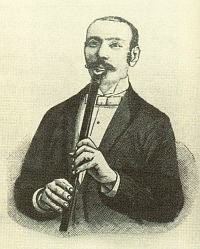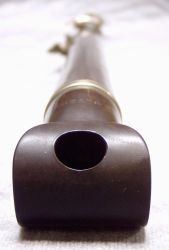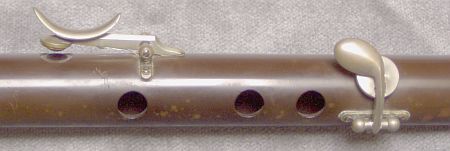

Carlo Tommaso Giorgi (1856–1953) was an Italian flutist, acoustician, and businessman who developed and announced an 11-hole keyless flute in 1886. The instrument has a cylindrical bore; it is held vertically, but has a flute-type embouchure. Giorgi's instruments were manufactured by Maino & Orsi in Milan and Joseph Wallis & Son in London. Giorgi wrote "keys are not necessary, but they can be furnished..." The instrument below, like many manufactured by Wallis, has three keys.


The Giorgi flute is interesting—even fascinating—and we have a number of things to say about it. But it is not really important in the history of mainstream flutes or in performance practice. It was not adopted by major players and did not have an influence on major composers.
The embouchure hole is on a mouthpiece with a tuning slide. It is shown slightly extracted below. The photo on the right is how the player would see it just before blowing.


The Giorgi flute was commonly made of ebonite, with thin walls. (Ebonite is jet black when new or polished, but tarnishes to a greenish brown.) The eleven holes are of the same size and placed in the acoustically correct positions to give the eleven semitones D# through C# of the equal-tempered scale, with the open end providing D. The eleven holes were to be controlled by the eight fingers of both hands, both thumbs, and the side (phalange) of the left hand first finger.
It can be difficult to support and play the instrument because the hand position and required stretch are not comfortable for many hands. Giorgi preferred the keyless version, but open-standing keys are found on many instruments, to help with these problems. The number of keys may vary, but they are always open-standing and serve simply as extensions of the fingers. The Giorgi flute is an example of an open-key system that is not the Boehm system. Two of the keys on the above instrument can be seen in the photo below. The key on the upper left is for the side of LH1; the key on the right is for LH4. Between the holes for the tips of LH1 and LH2, but in back of the flute, there is a hole for the left hand thumb.

The idea of making a fully chromatic flute with 11 holes and few or no keys was not new to Giorgi. The concept had been considered as early as 1803 by H. W. Pottgiesser. Keys can complicate technique and get out of adjustment, as well as increase the cost of manufacture. A keyless flute became more practical when Giorgi had the idea to hold the flute vertically.
The acoustic properties of the Giorgi flute are somewhat different from those of transversely held flutes. The reason is presumably that the embouchure is at the very end of the tube. There is no cork and chamber of air between the cork and the embouchure hole as on transverse flutes. One property of the Giorgi flute is that the second and third harmonics speak well without venting, and are well in tune. Unassisted (i.e. unvented) third harmonics are used for the third octave notes from d''' to g'''#. (The only note regularly played as a third harmonic on the Boehm flute is d''', and here it is assisted with the C# hole as a vent hole.)
To be clear, we may number the holes 1 through 11. The fingering 1-2-3-4-5-6 (with the first six holes covered by the left hand) produces g'. When overblown, one gets g''. And when overblown further, d''' is heard. This is Giorgi's fingering for d'''; there is no venting by opening hole 1 as on the Boehm or simple system flutes. Similarly, d'''# is fingered 1-2-3-4-5, e''' is fingered 1-2-3-4, all the way to g'''# with all holes uncovered. Notice that there are no cross-fingered notes at all for these first two-and-a-half octaves. In this range, technique is vastly simplified, once one overcomes the problems of supporting the flute when the thumbs are off their holes, and using the side of LH1 as well as the tip. The fingerings for a''' through e'''' do involve cross-fingerings and appear to be ad hoc.
Some models of Giorgi flutes were furnished with open-standing keys for low C# and C, and a closed-standing key controlling a hole above hole 1, for some trills. Many trills are still awkward. Two fingers are always required for trills of a whole step.
